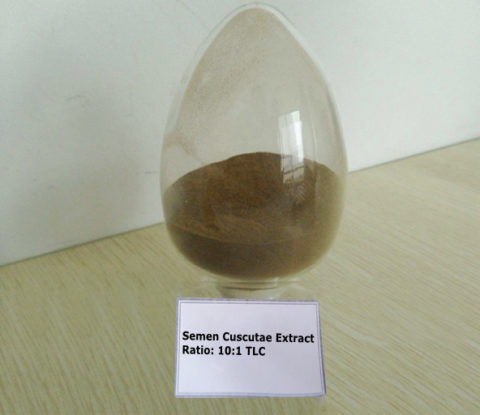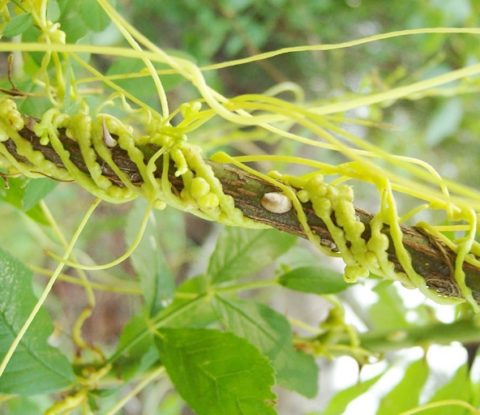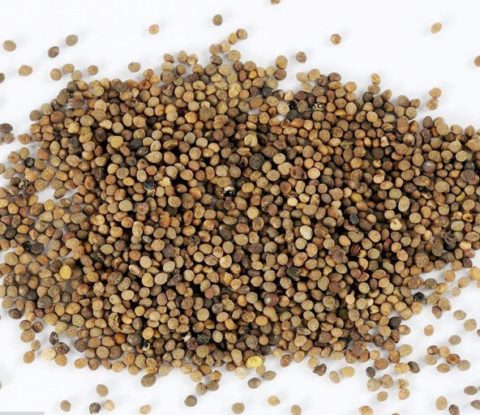
Semen Cuscutae Extract
【Latin name】: Cuscuta chinensis
【Other names】: Tu Si Zi, Semen Cuscutae, Chinese Dodder Seed, South Dodder Seed, Dodder’s seeds
【Product Specification】: 10:1, 20:1, 50:1
【Test method】: TLC
【Part used】: Seeds
【Product Appearance】: Brownish yellow powder
【Particle size】: 95% pass 80 mesh
Brief Introduction
Cuscuta (dodder) is a genus of about 100–170 species of yellow, orange, or red (rarely green)parasitic plants. Formerly treated as the only genus in the family Cuscutaceae, it now is accepted as belonging in the morning glory family, Convolvulaceae, on the basis of the work of the Angiosperm Phylogeny Group. The genus is found throughout the temperate and tropical regions of the world, with the greatest species diversity in subtropical and tropical regions; the genus becomes rare in cool temperate climates, with only four species native to northern Europe. Folk names include devil’s guts, devil’s hair, devil’s ringlet, goldthread, hailweed, hairweed, hellbine, love vine, pull-down, strangleweed, angel hair, and witch’s hair.
Dodder seed, also known as cuscuta seed or Tu Si Zi in mandarin, has long been considered a fabulous mild tonic used in Chinese herbal remedies. Just as its name implies, it comes from a parasitic plant that only survives by absorbing the essence from its host. Since ancient herbalists found no root from dodder, they thought it had some kind of magic power. It may be for this reason that it was listed as one of the superior herbs in the “Shen Nong’s Herbal Classic.” Being an excellent tonic for kidney, liver, and spleen, traditionally dodder seeds, alone or in combination with other ingredients, can assist the treatment of various diseases, in particular impotence, nocturnal emission, alopecia areata, habitual abortion, visual deterioration, frequent urination, melasma, lower back pain caused by kidney deficiency, chyluria, infertility, fetal irritability, and more.
Chemical Analysis
Chemical constituents in Semen Cuscutae include biological alkaloids, anthraquinone, coumarin, flavones, glycoside sterols, terpene, tannic acid and others. Compounds that contain flavones include quercetin, astragalin, and hyperin, with the total flavone amount being approximately 3.0% in the raw herb. Compounds that include sterols include: cholesterol, campesterol, beta-sitosterol, stigmasterol and beta-amyrin.The amino acid content is approximately 0.076%, and the total polysaccharide content is 8.5%-9.2% in the raw herb.Microelements identified so far in this herb are calcium (Ca), magnesium (Mg), iron (Fe), manganese (Mn), and copper (Cu).
Indications in TCM(Traditional Chinese Medicine)
1. Impotence, seminal emission, sterility, enuresis, frequent urination, leukorrhagia due to kidney deficiency
It can be extensively used in various syndromes due to kidney yang deficiency and insufficiency of kidney essence, because it is mild in the action of tonifying, warm without dryness, and it can both tonify kidney yang and supplement kidney essence, which means tonifying both yang and yin. In addition, it also can secure essence, reduce urination and stop leukorrhagia. It is commonly combined with spleen and kidney-tonifying, essence-nourishing and astringing herbs. Such as for impotence, seminal emission, sterility, enuresis, frequent urination due to kidney deficiency, it is combined with Gou Qi Zi, Wu Wei Zi and Fu Pen Zi in the formula Wu Zi Yan Zong Wan; for leukorrhagia and turbid urine due to insecurity of kidney deficiency, it is combined with kidney and spleen-tonifying, damp-dispelling, and leukorrhagia-stopping herbs, for instance, it is used with Lian Zi, Qian Shi and Fu Ling.
2. Deficiency of liver and kidney, dim and poor vision
It is indicated for dim and poor vision, hypopsia due to both liver and kidney deficiency, because it can tonify liver and kidney, nourish kidney essence, and improve vision. It is combined with herbs of tonifying liver and kidney, nourishing essence and blood, improving vision, for instance, it is used with Shu Di Huang and Gou Qi Zi in the formula Zhu Jing Wan from Zheng Zhi Zhun Shen.
3. Deficiency of both spleen and kidney, loose stool and diarrhea
It is indicated for loosing stool and diarrhea due to spleen deficiency or deficiency of both spleen and kidney, because it can tonify spleen and kidney, check diarrhea. It is commonly combined with spleen and kidney-warming herbs to check diarrhea of deficiency type. For loosing stool and diarrhea due to spleen deficiency, it is combined with spleen-qi-tonifying herbs, for instance, it is used with Ren Shen, Bai Zhu and Shan Yao in the formula Zhu Jing Wan from Zheng Zhi Zhun Shen. For chronic diarrhea due to deficiency of both spleen and kidney, it is combined with herbs to tonify spleen and kidney, astringe intestines to check diarrhea, for instance, it is used with Bu Gu Zhi, Sha Ren and Rou Dou Kou in the formula Pi Shen Shuang Bu Wan from Xian Xing Zhai Yi Xue Guang Bi Ji (Comprehensive Medical Notes of Xianxingzhai House).
4. Threatened abortion, metrorrhagia and metrostaxis due to liver and kidney deficiency, insecurity of thoroughfare and conception vessels
It is indicated for threatened abortion due to liver and kidney deficiency, insecurity of thoroughfare and conception vessels, malnutrition of fetus, or metrorrhagia and metrostaxis due to disharmony of sea of blood, because it can tonify liver and kidney, strengthen thoroughfare and conception vessels to prevent abortion, relieve metrorrhagia and metrostaxis. For threatened abortion, it is combined with liver and kidney-tonifying, and abortion-preventing herbs, for instance, it is used with Sang Ji Sheng, Xu Duan and E Jiao in the formula Shou Tai Wan from Yi Xue Zhong Zhong Can Xi Lu. For metrorrhagia and metrostaxis, it is combined with herbs of tonifying kidney, strengthening thoroughfare vessel, warming meridians and stopping blood. For instance, it is used with Du Zhong, Xu Duan, Ai Ye and Hai Piao Xiao. In addition, it can be used for diabetes due to kidney deficiency; it is used as pill singly in the formula Tu Si Zi Wan from Quan Sheng Zhi Mi Fang (Secret prescriptions of Quanshenzhi).
Pharmacological Actions
1.Chronic Prostatitis
Clinical studies
A formula of Semen Cuscutae, Rhizoma Dioscoreae Hypoglaucae, Rhizoma Dioscoreae, Fructus Alpiniae Oxyphyllae, Rhizoma Alismatis, Fructus Corni, and Herba Patriniae was used once per day to treat 53 cases of chronic prostatitis, for periods ranging from one to three months. The overall effective rate was reported to be 90.6%.
2. Improve Sperm Abnormality
Clinical studies
Semen Cuscutae was used together with Herba Cistanches, Fructus Lycii, Radix Polgoni Multiflori, Radix Rehmanniae Praeparata and Fructus Schisandrae to treat 105 cases of sperm abnormality. In this review paper, the type of sperm abnormality was not defined. The patients took the medicine either once a day or every other day. One month was regarded as one treatment period. After three treatment periods, 31 cases demonstrated complete recovery, 65 cases showed some extent of recovery while 11 cases experienced no change.
3. Gynecological Effects
Clinical studies
Effective in treating threatened abortion: Radix Dipsaci, Colla Corii Asini, Radix Codonopsis Pilosulae, Rhizoma Atractylodis Macrocephalae and Semen Cuscutae were used to treat 110 cases of threatened abortion. The patients took the medicine once a day for 10 days, and the overall effective rate was found to be 96.36%.
Effects on small uteruses (lnfantile uterus): In a study of 46 cases of infantile uteruses, patients were treated with a compound formula containing Semen Cuscutae , Radix Morindae Officinalis, Rhizoma Curculiginis, Herba Epimedii, Cervus elaphus, Radix Rehmanniae Praeparata and Radix Polgoni Multiflori. Starting from the 5th day of the menstrual cycle, the medication was taken, together with 1mg diethylstilbestrol, once a day for 20 days. Following treatment, 37 cases showed complete recovery while nine cases demonstrated improvement.
Animal studies
Gavage feeding 25g/kg Semen Cuscutae water extract to mice once a day for ten days was able to promote keratinization of vaginal tract epithelium and increase the weight of the uterus.
4. Improve Chranic Bronchits
Clinical studies
Effective in treating threatened abortion: Radix Dipsaci, Colla Corii Asini, Radix Codonopsis Pilosulae, Rhizoma Atractylodis Macrocephalae and Semen Cuscutae were used to treat 110 cases of threatened abortion. The patients took the medicine once a day for 10 days, and the overall effective rate was found to be 96.36%.
Effects on small uteruses (lnfantile uterus). In a study of 46 cases of infantile uteruses, patients were treated with a compound formula containing Semen Cuscutae , Radix Morindae Officinalis, Rhizoma Curculiginis, Herba Epimedii, Cervus elaphus, Radix Rehmanniae Praeparata and Radix Polgoni Multiflori. Starting from the 5th day of the menstrual cycle, the medication was taken, together with 1mg diethylstilbestrol, once a day for 20 days. Following treatment, 37 cases showed complete recovery while nine cases demonstrated improvement.
5. Delay Cataract Formation
Animal studies
Delay cataract formation in rats:
Rats on a galactose diet were given by gavage 4g/kg/day of a Semen Cuscutae water extract for 30 consecutive days. Results showed that Semen Cuscutae could delay the formation of cataracts in rats with a reported overall effective rate of 33.3%14. It was suggested that Semen Cuscutae did this by reducing the activity of aldose reductase and other enzymes that are responsible for galactose induced cataract formation and by enhancing the activities of sorbitol dehydrogenase, hexokinase, and glucose-6-phosphate dehydrogenase in the rat eye lens.
6. Yang Strengthening Effects
Animal studies
Improve the overall wellness of yang deficient mice:
After mice were rendered yang deficient by hydrocorticoid treatment, mice were gavage fed with a 5g/kg Semen Cuscutae decoction once a day for 7 days. It was observed that their body, kidney and thymus gland weight increased as well as increasing their white cell count, red cell count, hemoglobin content and superoxide dismutase (SOD) activity. Male mice gavage fed with 5g/kg Semen Cuscutae decoction once a day for 10 consecutive days showed prolonged swimming and hypoxia survival times. When fruit flies were fed with 0.5, 1.0 and 2.0% Semen Cuscutae water extracts for 10 days, their copulation frequency, within 11 minutes, increased. Their copulation rate increased by 47.49%, 65.52% and 78.86%, respectively.
7. Effects on Na+/K+-ATPase Activity
Animal studies
Mice gavage fed with a 6g/kg Semen Cuscutae decoction once a day for 10 days showed increase in Na+/K+-ATPase activity.
8. Effect on Heart Rate and Blood Pressure
Animal studies
Modulate heart rate and blood pressure: Decoction and tincture preparations of Semen Cuscutae were shown to affect contractility in an in vitro toad heart model. Heart rate was shown to increase with the decoction preparation but was reduced with the tincture. Intravenous injection of a 0.1g/kg Semen Cuscutae decoction to anaesthetized dogs showed reduction in their blood pressure.
9. Effects on the Endocrine System
Animal studies
Modulate the function of the anterior pituitary-hypothalamus-ovary axis:
When female rats were fed by gavage with 10g/kg water extract of Semen Cuscutae twice a day for five consecutive days, the weights of their anterior pituitary glands, ovaries and uterus were increased. Although no change in plasma LH levels was noted, the numbers of hCG/LH receptors increased such that the Ka value was smaller when compared to the control group.
Increase LRH sensitivity in ovariectomized rats: Ovariectomized rats were fed by gavage with 10g/kg water extract of Semen Cuscutae twice a day for five days. On day six, following anesthesia, the animals were i.v. injected with d-C-LRH (luteinizing releasing h-ormone). Results showed that Semen Cuscutae was able to further promote luteinizing h-ormone (LH) secretion induced by LRH. Plasma LH levels of Semen Cuscutae treated rats reached its highest peak 90 minutes after d-C-LRH injection with an average percentage increase of 241.58%. This study demonstrated that the stimulatory effects of Semen Cuscutae on yellow body (corus luteum) production along the hypothalamus-pituitary-ovary axis were not due to its direct stimulation on the pituitary; but thought to be due to Semen Cuscutae’s ability to increase ovary receptor sites sensitive towards LRH and LH, respectively.
10. Anti-aging Effects
Animal studies
Mulberry leaves, soaked with a 20% Semen Cuscutae decoction, were fed to silkworms three times a day. Results showed that Semen Cuscutae could prolong the larval stage of the worms, as well as their lifespan.
11. Anti-cancer Effects
Cell culture studies
At concentrations of 300mg/ml and 3000mg/ml, Semen Cuscutae water extracts were able to inhibit DNA synthesis in Ehrlich ascite carcinoma cells.
12. Anti-bacterial Effects
Cell culture studies
Decoction of Semen Cuscutae has been shown to have in vitro inhibitory effects on Staphylococcus, Shigella flexneri, and Bacillus typhosus.






